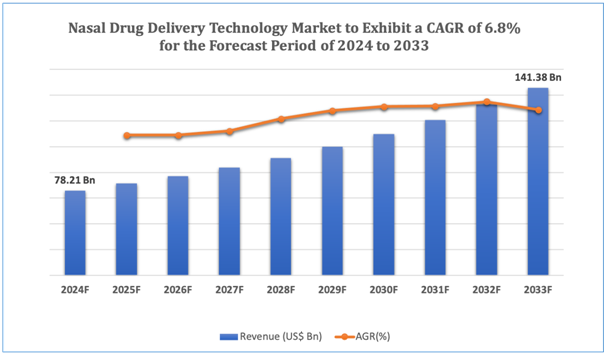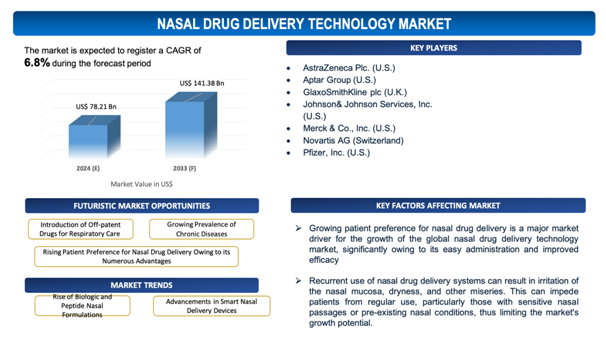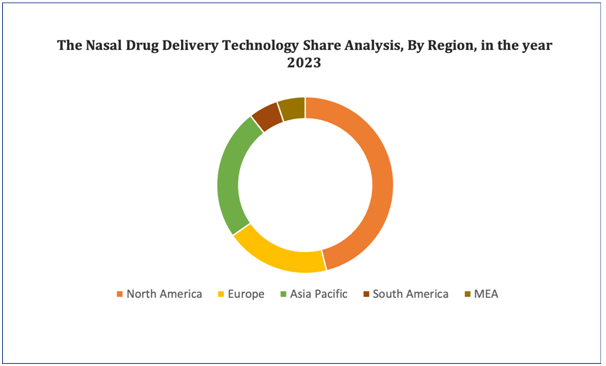Nasal Drug Delivery Technology Market Overview
The global nasal drug delivery technology market is estimated to be worth over USD 141.38 Bn in 2033 and is expected to grow at CAGR of6.8% during the forecast period (2024-2033).
Nasal drug delivery technology is transforming the pharmaceutical panorama by providingan efficient and unique approach of administering medications. This approach leverages the rich vascularization and porous nature of the nasal mucosa to supportexpeditious drug absorption directly into the bloodstream, circumventing the gastrointestinal tract and first-pass metabolism in the liver. This leads tofaster onset of action and enhanced bioavailability for various medications. The nasal route is specificallybeneficial for drugs that are poorly absorbed orally or are pliant to degradation in the digestive system. In addition, it offers a non-invasive, user-friendly substitute to injections, improving patient compliance and convenience, particularly in the management of chronic conditions and for those with needle phobia.
Latest advancements in nasal drug delivery systems comprise the development of sophisticated formulations such as liposomes, nanoparticles, and mucoadhesive gels, which enhance the stability and residence time of drugs in the nasal cavity. These advancements ensure continued and regulated release of therapeutic agents, further improving efficacy. Nasal delivery is also being explored for systemic treatments, including hormones, vaccines, and emergency medications like naloxone for opioid overdose, where swift action is critical.
In addition, the technology is amplifying the boundaries of central nervous system (CNS) therapies. By exploiting the nose-to-brain pathway, drugs can be directly delivered to the brain, bypassing the blood-brain barrier. This has substantial implications for treating neurological disorders such as Parkinson's disease, Alzheimer's disease, and migraines, providing new commitment for effective management of these conditions.
Therefore, nasal drug delivery technology is revolutionizing the drug delivery panorama by offeringa efficient, versatile, and patient-friendly substitute to conventional methods, with numerous applications scaling from local treatments to systemic therapies and CNS drug delivery.
Figure 1. Nasal Drug Delivery Technology: Market Size

Get more details on this report - Request Free Sample
Key Market Insights
The global nasal drug delivery technology market is witnessingrobust growth, fuelled by the growing prevalence of chronic diseases, soaring demand for non-invasive drug delivery methods, and developments in nasal formulation technologies. The market is projected to evolvestrongly over the forthcoming years, with significant developments cored around improving drug bioavailability and patient compliance. Leading players in the market are aiming their focus on novel technologies such as mucoadhesive formulations, nanocarriers, and the development of complex drug-device combinations that ensure accurate dosing and enhanced drug stability.
One of the most major developments is the emergence of intranasal vaccines, specificallypropelled by the COVID-19 pandemic, which has highlighted the necessity for swift, scalable, and non-invasive vaccination techniques. In addition, developments in the delivery of biologics and peptides via the nasal route are remarkable, as these large molecules conventionally face barriers with oral administration owing to degradation in the gastrointestinal tract.
The market is also witnessinggreater application in the treatment of CNS disorders through the nose-to-brain delivery route, providing promising solutions for conditions like Alzheimer's and Parkinson's diseases. Advanced delivery systems such as metered-dose sprays and powder formulations are being developed to improve the effectiveness and precision of nasal drug delivery.
Overall, the nasal drug delivery technology market is characterized by dynamic advancements and holds significant promise for transforming the administration of a broadscale of therapeutic agents.
Market Dynamics
Market Drivers
Rising Patient Preference for Nasal Drug Delivery Owing to its Numerous Advantages
Growing patient preference for nasal drug delivery is a major market driver for the growth of the global nasal drug delivery technology market, significantlyowing to its easy administration and improved efficacy. Patients increasingly favour nasal delivery methods because they are non-invasive, eradicating the anxiety and discomfort related to injectionsand needles. This preference is specifically pronounced among paediatric and geriatric populations, who often encounterrestraints with conventional drug administration routes. Nasal delivery provides a user-friendly substitute that can be easily self-administered, enhancing adherence to medication regimens and overall patient compliance.
In addition, the efficacy of nasal drug delivery is a compelling factor in its growing popularity. The nasal cavity's rich vascularization enables for swift absorption of drugs directly into the systemic circulation, leading toquicker onset of action in comparison to oral or injectable routes. This is specifically beneficial for medications necessitating quick relief, such as those for pain management, migraine, and emergency treatments like naloxone for opioid overdoses. Improved bioavailability is another benefit, as drugs delivered nasally bypass the gastrointestinal tract and first-pass metabolism in the liver, resulting in more efficient and consistent therapeutic outcomes.
The effectiveness and convenience of nasal drug delivery streamline with the surging demand for personalized and patient-centric healthcare solutions. This trend is fuelling pharmaceutical companies to invest in developing innovative nasal formulations and developed delivery devices that cater to patient needs. As a consequence, the growing patient preference for this method is accelerating the market forward, underlining its role as a leading driver in the expansion and evolution of the global nasal drug delivery technology market.
Market Restraints
With regard to numerous advantages of nasal drug delivery technology, the market faces several challenges due to the unique characteristics and requirements associated with these potent pharmaceutical products. Some of the key market challenges include:
- Potential for Nasal Irritation and Discomfort: Recurrent use of nasal drug delivery systems can result in irritation of the nasal mucosa, dryness, and other miseries. This can impede patients from regular use, particularly those with sensitive nasal passages or pre-existing nasal conditions, thus limiting the market's growth potential.
- Complexity in Formulation Development: Developing effective and stable nasal formulations, specifically for biologics and large molecules, poses major challenges. Ensuring drug stability, appropriate absorption, and avoiding degradation within the nasal cavity need advanced technologies and substantial R&D investments. This complication can decelerate product development and increase costs, impeding market expansion.

Get more details on this report - Request Free Sample
Market Opportunity
Introduction of Off-patent Drugs for Respiratory Care
Since patents for numerous major respiratory medications expire, generic versions can be cultivated and marketed, increasing accessibility and affordability for patients. This transitionpaving the way for pharmaceutical companies to advance and improve these generic drugs by integrating advanced nasal drug delivery technologies. Nasal delivery can enhance the therapeutic outcomes of respiratory drugs by providing faster relief and more direct delivery to the respiratory system, which is specifically beneficial for conditions like chronic obstructive pulmonary disease (COPD),asthma, and allergic rhinitis.
In addition, the availability of off-patent drugs minimizes the obstacle to entry for new players in the market, fostering competition and fuelling innovation. Companies can leverage existing formulations and emphasis on developing novel delivery systems that improve patient compliance and convenience. This can comprise the creation of metered-dose nasal sprays or other user-friendly nasal devices that ensure precise dosing and enhance drug stability and absorption.
Moreover, the cost-effectiveness of generic drugs coupled with the enhancedefficiency and ease of use of nasal delivery systems can result inwider adoption in both developed and emerging markets. Healthcare providers and patients alike may prefer these innovative nasal delivery options owing to their potential for swift symptom relief and minimizedadverse effects contrary toconventional inhalation therapies.
Therefore, the evolution of off-patent drugs for respiratory care offers a rich ground for the global nasal drug delivery technology market to develop, innovate, and improve the treatment landscape for respiratory conditions.
Market Trends
- Rise of Biologic and Peptide Nasal Formulations: The global nasal drug delivery technology market is experiencing a notable trend towards the advancement of nasal formulations for biologics and peptides. These large molecules, which are complicated to deliver orally owing to degradation in the digestive tract, benefit from the nasal route’s capability to offer direct and efficient absorption into the bloodstream. This trend is fuelled by the necessity for more effective delivery techniques for treatments like insulin, growth hormones, and monoclonal antibodies.
- Advancements in Smart Nasal Delivery Devices: Another prominent trend is the emergence of smart nasal delivery devices equipped with digital features such as feedback mechanisms, dose tracking, and connectivity to mobile applications. These developmentsfocuson improving patient adherence, ensure precise dosing, and offer valuable data for healthcare providers. By incorporating technology with drug delivery, these smart devices improve the overall therapeutic experience and outcomes, streamlining with the broader trend of digital health innovations.
Nasal Drug Delivery Technology Market: Key Segments
By Dosage Form
- Nasal Drops
- Sprays
- Powder
- Gel
By System
- Multidose
- Unit Dose
- BI-Dose
By Therapeutic Applications
- Rhinitis
- Congestion
- Vaccinations
By End User
- Hospitals
- Homecare
By Distribution Channel
- Hospital Pharmacies
- Retail Pharmacies
- Online Pharmacies
By Key Geographical Regions
- North America
- Europe
- Asia-Pacific
- Middle East and Africa
- South America
Figure 4. Nasal Drug Delivery Technology Market: Distribution by Region

Get more details on this report - Request Free Sample
Nasal Drug Delivery Technology Market: Regional Analysis
North America accounts for the dominating position in the nasal drug delivery technology market owing to the surge in disease incidence. In addition, the increasing consumer awareness about nasal products will further spur the growth of the nasal drug delivery technology market in the region over the foreseeable future.Other than that, Asia-Pacific is anticipated to witness significant amount of growth in the nasal drug delivery technology market attributing to the accessibility of efficient treatment methods and soaring disposable income levels. Additionally, the higher unmet clinical demands and soaring awareness about these products is further estimatedaccelerate the growth of the nasal drug delivery technology market in the region in the forthcoming years.
Leading Nasal Drug Delivery Technology Developers
Industry Trends and Global Forecasts, 2023-2035 report features an extensive study of the current market landscape, market size and future opportunities associated with the nasal drug delivery technologymarket, during the given forecast period. Further, the market report highlights the efforts of several stakeholders engaged in this rapidly emerging segment of the biopharmaceutical industry. Key takeaways of the Nasal Drug Delivery Technologymarket are briefly discussed below.
The report includes the list of players operating in the global Nasal Drug Delivery Technology market. Some of the key players include:
- AstraZeneca Plc. (U.S.)
- Aptar Group (U.S.)
- GlaxoSmithKline plc (U.K.)
- Johnson& Johnson Services, Inc. (U.S.)
- Merck & Co., Inc. (U.S.)
- Novartis AG (Switzerland)
- Pfizer, Inc. (U.S.)
Nasal Drug Delivery Technology Market: Key Developments
- In November 2023, Hovione, the specialist integrated CDMO, announced an expansion of its nasal drug delivery capabilities with the addition of a family of innovative nasal powder delivery devices developed in partnership with IDC.
- In January 2023, Aptar Pharma, part of AptarGroup, Inc., a global leader in drug delivery systems, services and active material science solutions, announces the launch of APF Futurity, its first metal-free, multidose nasal spray pump developed to deliver nasal saline and other comparable over-the-counter (OTC) formulations.
Scope of the Report
The market report presents an in-depth analysis of the various firms / organizations that are engaged in this market, across different segments, as defined in the below table:
|
|
Key Report Attributes |
Details |
||
|
|
Base Year |
2023 |
||
|
|
Forecast Period |
2024-2033 |
||
|
|
CAGR (2024-2033) |
6.8% |
||
|
|
Dosage Form |
|
||
|
|
System |
|
||
|
|
Therapeutic Applications |
|
||
|
|
End User |
|
||
|
|
Distribution Channel |
|
||
|
|
Key Geographical Regions |
|
||
|
Key Companies Profiled |
|
|
||
